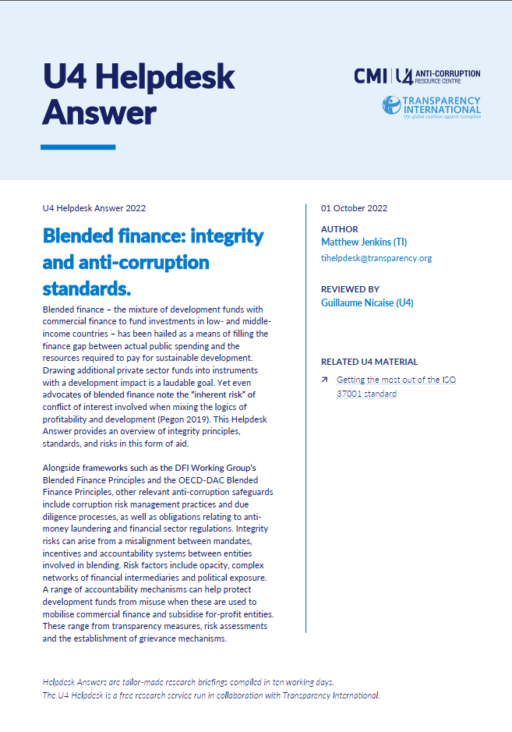
This Anti-Corruption Helpdesk brief was produced in response to a query from a U4 Partner Agency. The U4 Helpdesk is operated by Transparency International in collaboration with the U4 Anti-Corruption Resource Centre based at the Chr. Michelsen Institute.
Query
Please provide an overview of integrity principles, standards, and risks in blended finance
Summary
Blended finance – the mixture of development funds with commercial finance to fund investments in low- and middle-income countries – has been hailed as a means of filling the finance gap between actual public spending and the resources required to pay for sustainable development. Drawing additional private sector funds into instruments with a development impact is a laudable goal. Yet even advocates of blended finance note the “inherent risk” of conflict of interest involved when mixing the logics of profitability and development (Pegon 2019). This Helpdesk Answer provides an overview of integrity principles, standards, and risks in this form of aid.
Alongside frameworks such as the DFI Working Group’s Blended Finance Principles and the OECD-DAC Blended Finance Principles, other relevant anti-corruption safeguards include corruption risk management practices and due diligence processes, as well as obligations relating to anti-money laundering and financial sector regulations. Integrity risks can arise from a misalignment between mandates, incentives and accountability systems between entities involved in blending. Risk factors include opacity, complex networks of financial intermediaries and political exposure. A range of accountability mechanisms can help protect development funds from misuse when these are used to mobilise commercial finance and subsidise for-profit entities. These range from transparency measures, risk assessments and the establishment of grievance mechanisms.
Main points
- The participation of profit-driven actors in development work entails potentially novel integrity risks, while the complex financing arrangements and multi-layered governance structures involved in blended finance projects make managing transactions and monitoring results difficult.
- Core principles for the use of blended finance have been established by development finance institutions and the OECD-DAC group.
- Blended finance practitioners can draw on standards from both the public sector (such as aid effectiveness principles, corruption risk management practices and due diligence) and private sector measures (including anti-money laundering and financial sector regulations).
- Corruption risk factors in blended finance instruments relate chiefly to widespread opacity, particularly with regard to financial intermediaries. In practice, blended finance projects are considerably less transparent than projects funded using other forms of official development assistance (ITUC 2016: 45).
- Other integrity risks include the use of offshore financial centres, tied aid, lack of consultation with affected communities and misaligned incentives between the players involved. Where private sector entities manage concessional resources provided by public actors, conflicts of interest can be “particularly acute” (Pegon 2019).
- Relevant accountability mechanisms include greater disclosure of project level data, robust risk assessments, stringent due diligence, grievance mechanisms and competitive procurement processes.
Contents
- Introduction
- Relevant principles, standards and regulations
- Integrity risks in blended finance
- Accountability mechanisms for blended finance
- References
Caveat
In considering relevant standards for blended finance operations, this Helpdesk Answer restricts itself to international frameworks and principles; it does not cover national level regulations to which blended finance projects will be subject in different jurisdictions.
Authors
Matthew Jenkins, [email protected]
Reviewer
Guillaume Nicaise (U4)
Date
04/11/2022
Tags
 Download PDF
Download PDF
